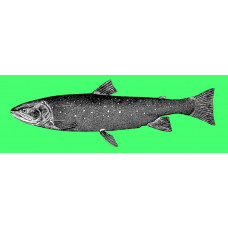Latin name
Salvelinus malma
Other name
Dolly varden, dolly varden char.
Identification
The body of the Dolly Varden trout is elongated, somewhat rounded, with the greatest depth of the body below the dorsal fin. The head is rather long. Gill rays 18-22, vertebrae (64) 65-68 (69), pyloric rays 22-27. The maxillary bone is long and slender, always well above the vertical of the posterior eye margin in adults.
Features of fish fins
Dorsal spines (total): 0; Dorsal soft rays (total): 10 - 16; Anal spines: 0; Anal soft rays: 10 - 15.
Pelvic fins with a free fleshy process at the end. Caudal fin pointed.
Fish colouring
The back and sides of Dolly Varden trout are olive green or dirty gray, tending to white on the belly. The body is covered with scattered pale yellow or pinkish yellow spots. There are no black spots or wavy lines on the body or fins. There are small red spots on the underside of the body. These are often indistinct. The fins are smooth and unmarked except for a few bright spots at the base of the caudal fin rays. S. malma is very similar in appearance to S. confluentus and S. alpinus.
Spawning males, especially from migratory populations, are reddened on the ventral surface and tip of the snout. The lower jaw, forehead, and parts of the head are black, while the back and sides are olive brown. The spots become lighter, orange-red, the pectoral and anal fins red-black with a white leading edge, the snout thickens, and the lower jaw is raised. Females change less.
Distribution
The species is distributed in coastal waters of the North Pacific Ocean from Puget Sound northward along the coast of British Columbia to the Alaska Peninsula and eastern Aleutian Islands, along the Bering Sea and Arctic Ocean to the Mackenzie River. The range in Asia extends southward across the Kamchatka Peninsula to northern Japan.
Habitat
Marine and freshwater, preferring brackish waters and temperate climates, benthopelagic species. Its depth range is from 0 to 200 meters. It is found in deep channels and backwaters of streams and small and large rivers, as well as in lakes and seas. It inhabits very clear mountain streams. Generally anadromous, but many populations are land-locked. Migratory fish may spend 2-3 years at sea, apparently close to shore, migrating upstream usually in fall and spawning in spring.
Size
The maximum length of males of this species is 127 cm. The total length is 37.5 cm. Maximum reported weight is 18.3 kg.
Behavior
There are three distinct forms. Catadromous or marine forms migrate from freshwater bodies and spend some time in the ocean or marine bays and estuaries to feed before returning to freshwater to spawn. Riverine forms live in temperate and large freshwater rivers and migrate to smaller tributaries to spawn. The third form lives in deep, cold lakes from which they eventually migrate to tributaries to spawn.
Food and feeding habits
Young Dolly Varden trout remain in streams for 3-4 years, feeding on insects, leeches, snails, and salmon eggs before entering brackish water to feed on insects, fish, and other invertebrates.
Reproduction
Adults from the sea and lakes enter rivers to spawn. The female chooses a nesting site and begins digging a burrow, while the male continues to groom her and chase away pesky males. Once the burrow is complete, both sink into it and release eggs and sperm. This may be repeated several times before the female covers the eggs, which swim along the edge of the redd, sweeping away small pebbles and other particles with her tail and anal fin. Later she may dig again and cover the eggs, preparing a new nest. Breeding is an annual event for southern populations and every two to three years in the Arctic. Males and females are reported to die after spawning.
Fishing
Economic importance is low. This species is considered and regulated as a commercial fish in the United States and Canada. It is a significant part of the Alaskan subsistence fishery. Anglers use a variety of baits to catch this fish, but when fishing during the spawning season, salmon eggs are the preferred bait.
Relationship with a person
Harmless. It is eaten fresh as well as roasted and baked.
| Classification | |
| Phylum | Chordata |
| Class | Actinopterygii |
| Squad | Salmoniformes |
| Family | Salmonidae |
| Genus | Salvelinus |
| Species | S. malma |
| Features | |
| Conservation status | Least Concern |
| Habitat | Pelagic |
| Life span, years | No information |
| Maximum body weight, kg | 18,3 |
| Maximum length, cm | 127 |
| Sailing speed, m/s | No information |
| Threat to people | Edible |
| Way of eating | Predator |
Dolly Varden trout
Tags: dolly varden trout

